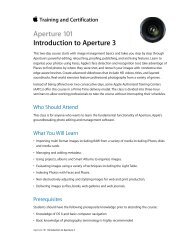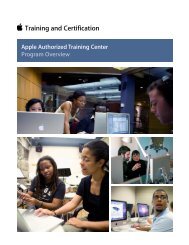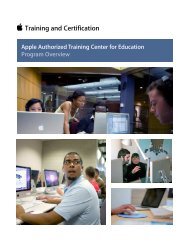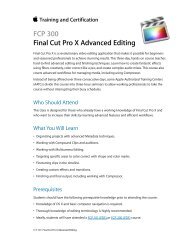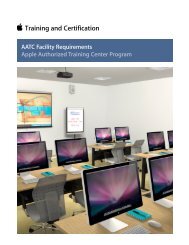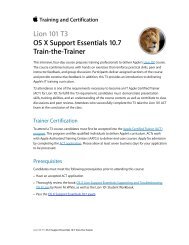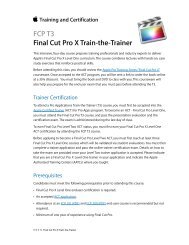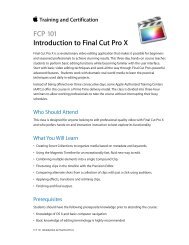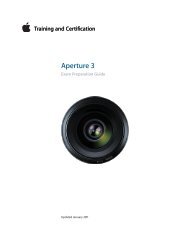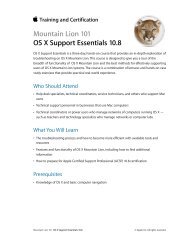OS X Support Essentials 10.8 - Training - Apple
OS X Support Essentials 10.8 - Training - Apple
OS X Support Essentials 10.8 - Training - Apple
You also want an ePaper? Increase the reach of your titles
YUMPU automatically turns print PDFs into web optimized ePapers that Google loves.
<strong>OS</strong> X <strong>Support</strong> <strong>Essentials</strong> <strong>10.8</strong> Exam Preparation Guide<br />
Lesson Fifteen review questions<br />
After completing Lesson Fifteen, you should be able to answer the<br />
following questions.<br />
1. What are the four default top-level folders visible in the<br />
Finder?<br />
2. What are six common system resources? What purpose does<br />
each resource serve? Where are they located in the file<br />
hierarchy?<br />
3. What are the four system resource domains? What purpose<br />
does each domain serve?<br />
4. What happens when a user double-clicks a font file?<br />
Answers<br />
1. The four default top-level folders visible in the Finder are:<br />
• Applications, containing applications all local users have<br />
access to<br />
• Library, containing system resources all local users have<br />
access to<br />
• System, containing necessary system resources<br />
• Users, containing all the local user home folders<br />
2. Six common system resources are:<br />
• Extensions, which attach themselves to the system kernel<br />
to provide hardware and peripheral driver support<br />
• Frameworks, which are shared code libraries that provide<br />
additional software resources for both applications and<br />
system processes<br />
• Fonts<br />
• Preference files, which contain application and system<br />
configuration information<br />
• LaunchAgents and LaunchDaemons, used by launchd to<br />
provide services that automatically start when needed at<br />
system startup, or at user login<br />
• Logs, which are text files that contain error and progress<br />
entries from nearly any application or system service<br />
3. The four system resource domains are:<br />
• User, containing applications and system resources specific<br />
to each user account<br />
• Local, containing applications and system resources<br />
available to all users on the local Mac<br />
• Network (optional), containing applications and system<br />
resources available to any Mac that has an automated<br />
network share<br />
24



